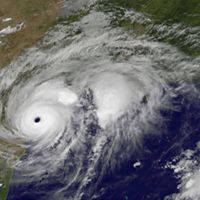ABOVE: Hurricane Harvey hit Texas in August 2017.
NASA/NOAA
Hurricanes are devastating, and we’re making them worse. Our activities, whether it’s by warming the climate or building concrete jungles, are intensifying rainfall and raising the risks of flooding, according to two papers published today (November 14) in Nature.
“Climate change has exacerbated rainfall and is set to enhance the wind speed,” Christina Patricola, a climate scientist at Lawrence Berkeley National Laboratory and coauthor of one of the studies, tells The Guardian. “My hope is that this information can be used to improve our resilience to the kinds of extreme weather events we are going to have in the future.”
She and her colleagues simulated how hurricanes such as Katrina in North America and Haiyan in Southeast Asia would have developed in different climates, from the pre-industrial and modern eras to three climate scenarios predicted for the...
See “Scientists Unite to Save ‘Monkey Island’ After Hurricane Maria” and “Wild Horses Can Handle Hurricanes. What About Climate Change?”
In the second study, Gabriele Villarini, a civil and environmental engineer at the University of Iowa, and her colleagues also ran climate models and found that the topography of Houston--mainly its human-made buildings—led to atmospheric drag, which increased Hurricane Harvey’s rainfall. Additionally, the surface of the city—its concrete and asphalt—increased flooding compared with what would have happened had the storm hit croplands.
“This paper represents a real advance in our understanding of hurricane impacts on urban areas,” Kerry Emanuel, a professor of atmospheric science at MIT who was not involved in either study, tells Bloomberg. The findings have “important implications for urban planning.”
Interested in reading more?







